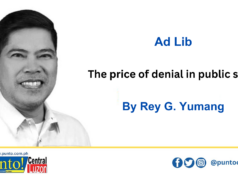PLAGIARISM IS defined in dictionaries as the “wrongful appropriation,” “close imitation,” or “purloining and publication” of another author’s “language, thoughts, ideas, or expressions,” and the representation of them as one’s own original work, but the notion remains problematic with nebulous boundaries.
The modern concept of plagiarism as immoral and originality as an ideal emerged in Europe only in the 18th century, particularly with the Romantic Movement, while in the previous centuries authors and artists were encouraged to “copy the masters as closely as possible” and avoid “unnecessary invention.”
The 18th century new morals have been institutionalized and enforced prominently in the sectors of academia and journalism, where plagiarism is now considered academic dishonesty and a breach of journalistic ethics, subject to sanctions like expulsion and other severe career damage.
Not so in the arts, which not only have resisted in their long-established tradition of copying as a fundamental practice of the creative process, but with the boom of the modernist and postmodern movements in the 20th century, this practice has been heightened as the central and representative artistic device. Plagiarism remains tolerated by 21st century artists.
Plagiarism is not a crime per se but is disapproved more on the grounds of moral offense, and cases of plagiarism can involve liability for copyright infringement.
If the above brief is bylined Bong Z. Lacson, then I am a damned plagiarist.
Attributing it properly to Wikipedia makes me a researcher.
Plagiarism is plain and simple stealing. The scale and scope of what is thieved make the difference between pilferage and plunder.
A sentence, a paragraph copied verbatim and passed on as one’s own comprises the former, a whole body of work – feature, essay, research paper, speech, critique, etc. – the latter. Still, and all, a violation of the Commandment “Thou shalt not steal.” And “Thou shalt not covet thy neighbor’s goods” too.
Mere translation of another’s work in another language does not make it as the translator’s own. Nothing lost in the translation, the original ideas, thoughts therein remain reposited in the author.
So Sen. Robert F. Kennedy could not have known a single word in Pilipino, still, his were the great ideas Sen. Tito Sotto appropriated as his own.
Yes, the plagiarist is in no way exculpated by his reformatting of the work, so long as the original ideas are kept en toto. It is like Barbie or Ken – pardon the banality of the analogy – no matter how a child dresses them her way, they remain Mattel’s.
Even more vulgar, as the Filipino witticism holds: Mag-amerikana man ang monkey, unggoy pa rin. Magpabango man si porky, baboy pa rin. Gone a bit off-tangent there maybe.
Paralleling the Sotto affair is the local media’s own current fixation on ethical questions rising from the publication of press releases.
Asks Headline’s Cha Cayabyab in Facebook: “What is unethical? Publishing a press release or writing for a government agency and for a newspaper at the same time? Know your terms, dear. Make sure you know me well before you make judgments.”
The direct addressee “dear” known only to her.
Still, I tabbed: No question of ethics in publishing a press release, so long as you don’t claim authorship of it if you did not write it.
For then, it becomes plagiarism, plain and simple.
The Philippine Daily Inquirer’s Tonette Orejas totally agreed, but then: “Problem is young writers these days just delete the names of PIA writers and claim it as theirs en toto. Bad!”
And the thread has gone on and on and on…
As it happens, it is not only young writers that claim authorship of press releases, whether coming from the Philippine Information Agency, the Public Relations Department of the Clark Development Corp., or from the information offices of the Capitol, and the cities of San Fernando and Angeles.
Outright plagiarism has become common practice here, reflective of the indolence, if not of the incompetence of many in the local media. Bad, really bad.
Many a time you see the same story by lined differently in other papers but tag lined “Press Release” with the corresponding source in Punto!
Yes, it is our policy to attribute the press release whence it cometh. If it is re-written and infused with additional facts and figures by our writers, then we find it meriting of his/her byline or tagline.
Cha’s other beef, writing for a government agency and for a newspaper at the same time, is a totally different matter. Ethics dictates that such writer identifies himself/herself as working with the government so the readers will have foreknowledge of his/her biases.
Plagiarism though is not always as easily delineated or defined as in the case of press releases. Or as always wilful, on the part of the writer.
I myself am in constant dread if I have inadvertently or unwittingly taken parts of someone else’s work and incorporated it in my own without the proper attribution.
It is easy – and I do this diligently – to cite reference works and authors quoted in my articles when I am directly noting them from the internet or from books on hand.
Due diligence however becomes fairly impossible when dredging one’s memory bank while writing, especially nearing deadline. It’s like: Are these words, phrases coming to mind originally mine?
Or are they figments from long memorized passages from hundreds of books and periodicals read, or maybe my personal impressions of them?
Authors may have been long forgotten but their ideas still remembered. Or remembered in name but not in work.
There is absolutely no wilful intention in me to take another’s work as my own. If you notice anything in my writings suspiciously similar to another’s, then – please – let me know ASAP.
I will damn that other for plagiarizing my work. If his came after mine.
I will damn myself, don sackcloth and sit in ashes. If his came before mine.
There’s no justification to plagiarism. Once you did it – and are found to have done it – there’s no other recourse but to own up to it and apologize.
No matter your being some senator of this republic.




